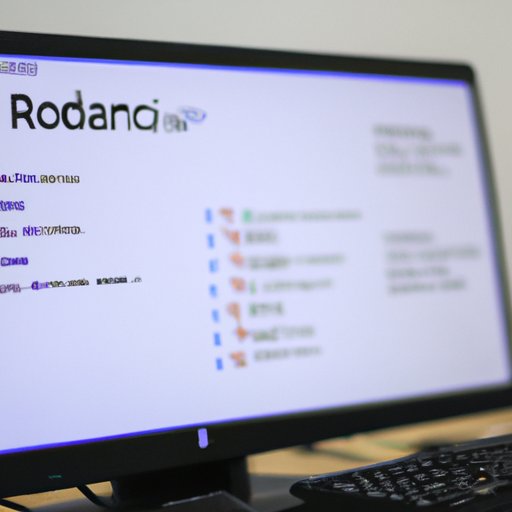Introduction
Robotics is the field of engineering that deals with the design, construction, operation, and application of robots. Robotics technology is used in a variety of industries including manufacturing, healthcare, entertainment, and education. In order to create effective and efficient robotic systems, programming languages are used to provide instructions to the robot. This article will explore the benefits of using programming languages for robotics, compare commonly used programming languages for robotics, and provide an understanding of the fundamentals of programming languages for robotics.
Exploring the Benefits of Using Programming Languages for Robotics
Using programming languages for robotics offers numerous benefits, such as increased efficiency, improved accuracy, and increased flexibility. Increased efficiency can be achieved by automating repetitive tasks, reducing the need for human labor. Improved accuracy can be gained by using precise instructions, eliminating the possibility of human error. Additionally, programming languages allow for greater flexibility when it comes to making changes or adding features to a robotic system. Programming languages also provide a way to easily transfer data between different components of a robotic system.

A Comparison of Commonly Used Programming Languages for Robotics
There are several programming languages that are commonly used for robotics, including C/C++, Python, Java, and MATLAB. Each language has its own advantages and disadvantages, and the choice of language depends on the specific requirements and goals of the project.
C/C++ is one of the most popular programming languages for robotics due to its speed and efficiency. It is a low-level language, meaning it provides more control over the hardware and software of the robot. C/C++ is also widely used in industry and academia, making it easier to find resources and support. However, C/C++ is a difficult language to learn, and it requires a lot of time and effort to master.
Python is another popular programming language for robotics. It is a high-level language, meaning it is easier to learn and use than C/C++. Python is often used for rapid prototyping and data analysis, and it makes it easier to write complex algorithms. Additionally, Python has many libraries and frameworks that make it easier to develop robotic applications. The downside to Python is that it is not as fast or efficient as C/C++.
Java is another popular programming language for robotics. It is a high-level language, making it easier to learn and use than C/C++. Java is also platform-independent, meaning it can be used on multiple platforms with minimal changes. Additionally, Java has a large number of libraries and frameworks that make it easier to develop robotic applications. The downside to Java is that it is slower and less efficient than C/C++.
MATLAB is a proprietary programming language developed by MathWorks. It is often used for scientific and engineering applications, including robotics. MATLAB is a high-level language, making it easier to learn and use than C/C++. Additionally, MATLAB has many tools and libraries specifically designed for robotics, making it easier to develop robotic applications. The downside to MATLAB is that it is expensive and not as fast or efficient as C/C++.
The Best Programming Languages for Robotics
When choosing the best programming language for robotics, it is important to consider the pros and cons of each language. C/C++ is often considered to be the best language for robotics due to its speed and efficiency. It is also widely used in industry and academia, making it easier to find resources and support. Python is also a popular choice for robotics due to its ease of use and wide range of libraries and frameworks. Java is another popular language for robotics due to its platform-independence and large number of libraries and frameworks. Finally, MATLAB is a good choice for robotics due to its specialized tools and libraries.
When selecting a programming language for robotics, it is important to consider the features and capabilities of the program. For example, some programs may have features specifically designed for robotics, while others may be more general-purpose. Additionally, it is important to understand the costs involved in using a particular language. Some languages may require additional software or hardware, while others may be available for free.

Understanding the Fundamentals of Programming Languages for Robotics
In order to effectively use a programming language for robotics, it is important to understand the fundamentals of programming. Syntax refers to the rules for writing code, such as how to declare variables and use loops. Variables are pieces of data that can be used to store information, such as the coordinates of a robot. Loops are used to repeat sections of code, such as moving a robot from one point to another. Understanding these fundamentals is essential for creating effective robotic applications.

How to Choose the Appropriate Programming Language for Robotics
Choosing the right programming language for robotics can be a challenge. It is important to consider your goals and evaluate the features and capabilities of the program. Additionally, it is important to understand the costs involved in using a particular language. Once you have evaluated the options, you can choose the language that best meets your needs.
Conclusion
Programming languages are essential for creating effective and efficient robotic systems. There are several programming languages that are commonly used for robotics, including C/C++, Python, Java, and MATLAB. When choosing a programming language for robotics, it is important to consider the features and capabilities of the program, as well as the costs involved. Understanding the fundamentals of programming is also essential for creating effective robotic applications. By following these guidelines, you can choose the appropriate programming language for your robotics project.
(Note: Is this article not meeting your expectations? Do you have knowledge or insights to share? Unlock new opportunities and expand your reach by joining our authors team. Click Registration to join us and share your expertise with our readers.)
